Songwriting For Music Producers: Different Chord Types and How to Play Them
When looking at a piano, what do you see? Do you see a world of chord opportunities? Do you see which notes are which? Or, like many, do you see a collection of black & white keys that make a sound when they’re pressed?
If you do fall into that final category then this blog post is for you. We’re embarking on a journey that entails five blog articles that break down how to write better chords and melodies.
That hunger you feel to be a better music composer will soon be fed. This guide alone will give you a method of remembering what chords evoke what emotions and what notes you need to press for each chord.
By understanding chords, you’re about to elevate your musical compositions to new heights. Your listeners and/or future listeners will be dancing around their kitchens, tapping their feet, and bopping their heads to your music before you know it.
Let’s go!
What is a Chord?
A chord is a combination of two or more individual notes. There are multiple chord types, and each has its own unique sound. There are major and minor chords, which we’ll explore first, and there are diminished chords, 7th chords, and more.
The foundation of all chords is a singular note – and that’s called the root note. For example, the root note of C Major is the note C, the root note of D Major is the note D, etc. Most chords are made up of three notes, but only two are actually needed to make a chord. A three-note chord is called a triad.
What Does Chord Quality Mean?
As we said, there are multiple chord types. Major, Minor, etc. These types of chords are known as chord qualities. A major is a chord quality, a minor is a chord quality, etc. What chord you play depends on the intervals between the notes. If you’re unfamiliar, an interval is a distance between tones (notes).
The C Major chord uses the notes C, E, and G notes. Between the notes, C and E are the notes C#, D, and D#. So, counting up from C to E gives you four intervals.
Every chord quality has its own distinct sound. Some sound joyful, others sound melancholy. Others sound curious. Understanding what chord qualities sound like will allow you to write better chord progressions. If you know what emotions you want to convey (happy or said, etc.) and you have the knowledge of what chord quality represents said emotion… you’re onto a winner.
What Are The Different Chord Types?
There are a total of 9 chord types that having knowledge of will excite your music!
Major Chords
You may already know this, but major chords sound happy and joyful.
A major chord consists of a root note (1st), a major 3rd (+4 semitones), and a perfect 5th (+7 semitones).
Going back to our C Major example where we counted 4 intervals between C & E, these four intervals make up a major 3rd. This is because we counted 4 semitones from C to E.
C to G, on the other hand, has seven semitones between C and G. These seven semitones make up perfect 5th. If it makes it easier to count, you can just count 3 semitones from your major 3rd to get your perfect 5th.
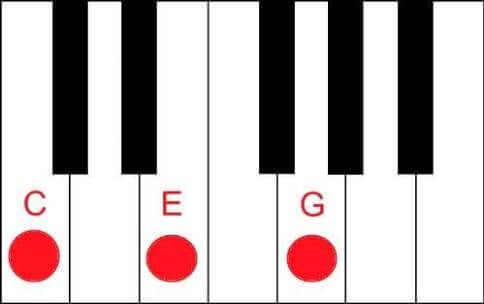
A simple formula to remember the structure of major chords is: 1-4-3.
The root note (1), the major 3rd (+4 semitones the from root note), and major 5th (+3 semitones from minor 3rd).
Minor Chord
A minor chord is made up of a root note (1st), a minor 3rd (+3 semitones), and a perfect 5th (+7 semitones).
You can see from this breakdown that the difference between a major and minor chord is simply one-note. Rather than count 4 semitones from the root note we only count 3. But don’t be fooled by this minute difference. The chord sounds very different and conveys different feelings.
You can see from this breakdown that the difference between a major and minor chord is simply one-note. Rather than count 4 semitones from the root note we only count 3. But don’t be fooled by this minute difference. The chord sounds very different and conveys different feelings.
C Minor, then, is made up of the notes C, D sharp/E flat, and G.
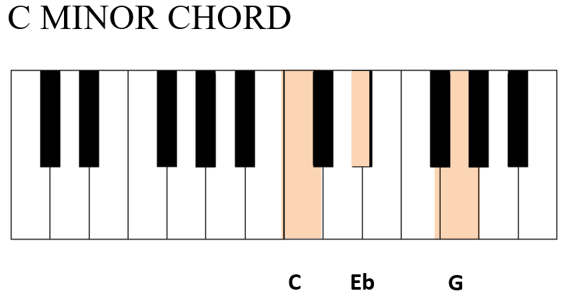
A simple formula to remember the structure of minor chords is: 1-3-4.
The root note (1), the minor 3rd (+3 semitones from root note), and major 5th (+4 semitones from minor 3rd).
Diminished Chords
Diminished Chords sound tense and unpleasant.
A diminished chord is made up of a root note (1st) a minor 3rd (+ 3 semitones), and a diminished/flat 5th (+6 semitones).
Used much less than major and minor chords, but diminished chords do have their place. They are amazing at creating tension!
A Cdim chord is made up of C (the root note), D sharp/E flat (+3 semitones), and then a F sharp/ G flat (+6 semitones).

The formula to remember diminished chords is 1-3-3.
Major Seventh Chords
Major seventh chords are softer than other chords. Many people describe them as “jazzy” chords as they’re used all of the time in jazz music.
A major seventh chord is made up of a root note (1st), a major 3rd (+ 4 semitones), a perfect 5th (+7 semitones), and a major 7th (+11 semitones). That’s one additional note compared to triad chords.
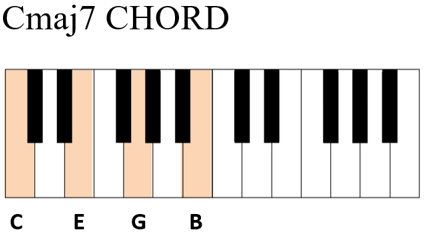
This can make major seventh chords easier to remember as they’re a major triad plus a fourth note that’s 11 semitones higher than the root note.
The formula for a major seventh chord is 1-4-3-4.
Minor Seventh Chord
If a major seventh chord is a major triad with a major seventh tone on top, then a minor seventh is a minor triad plus a minor seventh tone on top. Compared to major seventh chords that are soft, minor seventh chords are moody.
A minor seventh chord is made up of a root note (1), plus a minor 3rd (+3 semitones,), a perfect 5th (+7 semitones), and then a minor 7th (+10 semitones).
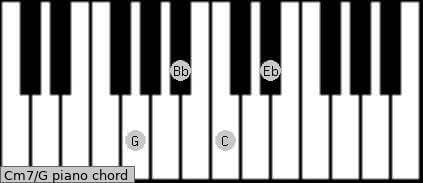
The formula for a minor seventh chord is 1-3-4-3.
Dominant Seventh Chords
As the name suggests, dominant seventh chords are thought to be strong and represent restlessness. You can usually find them in jazz and blues music.
A dominant seventh chord is made up of a root note (1st), a major third (+4 semitones), a perfect 5th (+7 semitones), and a minor 7th (+10 semitones).

The formula for a dominant seventh chord is 1-4-3-3.
Suspended Chords (sus2 & sus4)
Every chord we have so far discussed has been made up of a root note, a third, and a fifth. The chords we have so far covered have are the most common chords found.
But what if I told you that not every chord follows this structure? There are, in fact, chords that don’t follow this formula, such as suspended chords.
There are two common suspended chords, and these are sus2 sus4 chords. The numbers 2 & 4 represent the scale degree being held rather than the chord tone which is usually =present in a given chord (fifths, sevenths, etc.)
Sus2 Chords
A sus2 chord is made up of a root note (1st), a major second (+2 semitones), and a perfect fifth (+7 semitones).
A useful way to think about sus2 chords is that they’re the same as major chords, but rather than a major 3rd they have a major second instead.
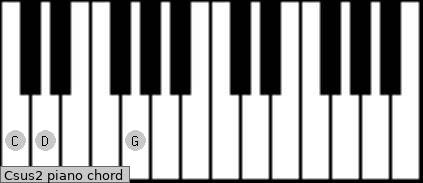
The formula for building a sus2 chord is 1-2-5.
Sus4 Chords
A sus4 chord is made up of a root note (1st), a major fourth (+5 semitones), and a perfect fifth (+7 semitones).
Again, think about them as major chords with a perfect fourth instead of a major third!
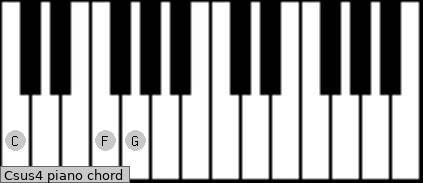
The formula for building a sus4 chord is 1-5-2.
Augmented Chords
Augmented chords are full of suspense and portray an anxious feeling.
An augmented chord is made up of a root note (1st), then a major third (+4 semitones), and an augmented 5th (+8 semitones).
Think about augmented chords like major chords, but the top note is raised by one semitone. After all, augmented means “raised in size”.

The formula for building an augmented chord is 1-4-4.
Extended Chords
Finally, we have Extended Chords. We’ve discussed chords that have intervals from 2 to 7. Extended chords extend beyond these chords, and have intervals above a seventh. We’re going to discuss Major and Minor Ninth, eleventh, and thirteenth chords.
There are more types of extended chords, and they’re all common in music such as jazz and R&B. These are some pretty advanced chords. You’ll find that you will learn them easier if your understanding of the chords we have already discussed is strong. Don’t be afraid to go back over the chords we have discussed – there was a lot of information to take in!
Major Ninth Chords
Major Ninth chords are made up of a root (1st), then a major 3rd (+4 semitones), a perfect 5th (+7 semitones), Major 7th (+11 semitones), and a Major 9th (+14 semitones).
Major ninth chords are pretty similar to major seventh chords. The additional ninth adds more personality to the chord, so they’re great for adding a jazzy feel to your music.
The formula for major ninth chords is: 1-4-3-4-3
Minor Ninths Chords
Minor ninth chords are made up of a root note, a minor 3rd (+3 semitones), a perfect 5th (+7 semitones), a minor 7th (+10 semitones), and a major 9th (+14 semitones).
They’re very similar to major ninth chords, only they have a minor 3rd and 7th instead of a major seventh.
The formula for minor ninth chords is 1-3-4-3-4.
Dominant Ninth Chords
A dominant ninth nine chord is made up of a root (1st), major 3rd (+4 semitones), perfect 5th (+ 7 semitones), minor/flat 7th (+10 semitones), and major 9th (+14 semitones).
The formula for Dominant ninth chords is 1-4-3-3-4.
Major Eleventh Chords
A major eleventh chord is made up of a root note (1st), a major third (+4 semitones), a perfect 5th (+7 semitones), a major 7th (+11 semitones), a major 9th (+14 semitones), and an 11th (+17 semitones).
The formula for major eleventh chords is 1-4-3-4-3-3.
Minor Eleventh Chords
cMinor eleventh chords are made up of a root note (1st), a major third (+4 semitones), a perfect 5th (+7 semitones), a major 7th (+11 semitones), a major 9th (+14 semitones), and an 11th (+17 semitones).
The formula for a minor eleventh chord is 1-3-4-3-4-3.
You can find a multitude of chord progressions and melodic sampes on Mixxed!
The sampling revolution has risen in popularity and shaped music since the early 1970s. Sample culture continues to transform how millions of artists and producers do their thing in DAWs.
You too can break conventional norms, challenge the status quo, and open Pandora’s box of sound design.
Mixxed works with a growing number of sample labels and contributors to provide you with an affordable sample subscription service that’s more accessible than any before.
You’ll have access to our growing catalogue of loops, one-shots and sound effects that you can browse, download and keep forever for less than $3 a month.
Sign up today to find your sound!
